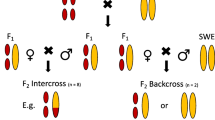Summary
In the south-east of France, local honey bees possess only the B allele at the MDH locus, whereas the races which are usually imported into this area do not have this allele. The proportion of non-B genes in a sample of drones was used to measure the “genetic pollution” in the local population. Within the course of a breeding scheme of local bees, 99 queens, whose genotypes are BB, were naturally mated between April 25 and June 10, 1985 at la Tave (Gard, France). Twenty daughters-workers of each queen were analysed at the MDH locus. The frequency of the B allele in drones that mated with these queens is estimated by the proportion of workers with genotype BB and the genetic pollution by the cumulated frequency of the other alleles. The sampling variances of these frequencies involve a coefficient which is a function of the average number of drones mated with a queen. This latter parameter is estimated through the maximum likelihood method. In addition to the three well-known alleles, a rare allele (frequency=0.0055), possibly equivalent to the S1 allele described by Badino et al. (1983), has been found in three different colonies. Cumulating the frequencies of the non-B alleles results in an estimation of the genetic pollution equal to 0.0394 (±0.0071). This low value allows us to proceed to the next step of the selection project. The mean number of drones mated to a queen is 12.4 with a (10.4–19.3) confidence interval at the 90% level.
Similar content being viewed by others
References
Adams J, Rothman ED, Kerr WE, Paulino ZL (1977) Estimation of the number of sex alleles and queen mating from diploid males frequencies in a population of Apis mellifera. Genetics 86:583–596
Badino G, Celebrano G, Manino A (1983) Population structure and Mdh-1 locus variation in Apis mellifera ligustica. J Hered 74:443–446
Cornuet JM (1979) The MDH system in the honeybees (Apis mellifera L.) of Guadaloupe. J Hered 70:223–224
Cornuet JM (1982) The MDH polymorphism in some west Mediterranean honeybee populations. In: IUSSI Congress. Boulder Colo USA, pp 5–6
Sheppard WS, Berlocher SH (1984) Enzyme polymorphism in Apis mellifera from Norway. J Apic Res 23:64–69
Sheppard WS, Berlocher SH (1985) New allozyme variability in Italian honey bees. J Hered 76:45–48
Sylvester MA (1976) Allozyme variation in honeybees (Apis mellifera L.) PhD Thesis, University of California (USA)
Taber S, Wendel J (1958) Concerning the number of times queen bees mate. J Econ Entomol 51:786–789
Author information
Authors and Affiliations
Rights and permissions
About this article
Cite this article
Cornuet, J.M., Daoudi, A. & Chevalet, C. Genetic pollution and number of matings in a black honey bee (Apis mellifera mellifera) population. Theoret. Appl. Genetics 73, 223–227 (1986). https://doi.org/10.1007/BF00289278
Received:
Accepted:
Issue Date:
DOI: https://doi.org/10.1007/BF00289278




